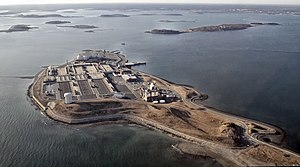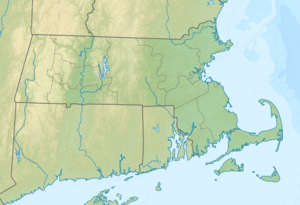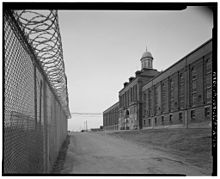Deer Island, Massachusetts
| Deer Island | ||
|---|---|---|
| Aerial photograph of Deer Island (2008) | ||
| Waters | Boston Harbor , Atlantic Ocean | |
| Geographical location | 42 ° 21 ′ N , 70 ° 57 ′ W | |
|
|
||
| This 19th century map shows Deer Island as a fully fledged island | ||
Deer Island is a peninsula in Boston Harbor . It is located on Quincy Bay 5.33 mi (8.6 km ) from downtown Boston in the state of Massachusetts in the United States . Deer Island has an area of 265 acres (1.1 km² ), of which 80 acres (0.3 km²) form a mudflat and are only above the surface of the water at low tide . The island belongs to Boston and is part of the Boston Harbor Islands National Recreation Area .
geology
In order to create a visual barrier between Winthrop and the sewage treatment plant, a drumlin was relocated on the island in such a way that it forms a berm and takes the plant out of sight of the city.
history
The present-day peninsula was originally a fully fledged island and has only existed in this form since 1938, when a hurricane wreaked havoc in the region and filled the Shirley Gut , which until then separated the island from the mainland, with sand removed from the surrounding coastal areas. The former island was already used by the Indians and served a variety of purposes throughout its history; On it lived temporarily quarantined immigrants, farmers, wise men, the destitute, the military and tens of thousands of prison inmates in the former County House of Correction .
The island's past, however, is less glorious. The low point was reached during the King Philip's War , when the island served as an internment camp for around 500 Indians in the winter of 1675/1676 , who had been driven from their homes and settlements by the colonists. Many of them died from lack of food and the low temperatures.
When the Great Famine in Ireland in the 19th century drove many Irish immigrants to the United States, thousands of them ended up on Deer Island. In June 1847, the city of Boston opened a hospital on the island that treated nearly 5,000 people over the next two years. However, more than 800 died and were buried in the cemetery that is still on the island today. A poor house was opened in 1850, but it was closed again after a few years and converted into a prison.
The island has been used as a site for sewage treatment plants since the late 19th century. Today, this is done by the Deer Island Sewerage Treatment Plant , which treats wastewater for the entire Greater Boston metropolitan area and is one of the largest and most modern wastewater treatment plants in the United States.
Suffolk County House of Correction
From 1880 to 1991, was on the island prison Suffolk County House of Correction initially retaining the name - to which the former poorhouse House of Industry was rebuilt -. The House of Correction was located in South Boston until 1896, but was then moved to the island with its inmates within four years. The name of the prison has also been changed accordingly. Well-known inmates included Luigi Galleani , John Runnings , Prescott Townsend , Mark Wahlberg , Margaret Brown (also known as Old Mother Hubbard ) and Oliver Garrett . In 1992 the prison was demolished to make room for the construction of the sewage treatment plant.
Fort Dawes
Fort Dawes, which no longer exists today, was once the largest defensive structure in the Boston harbor area with an area of around 100 acres (40.5 hectares) and was still in use during World War II . In the 1990s it was completely destroyed in the course of the construction of the sewage treatment plant.
In 1907 the first parts of Fort Dawes were completed. They comprised a station for a commanding officer, from which port defense against attacking ships could be organized, a mine observation station as part of the system for detecting detonating water mines in the northern port area, and two weapons control systems, with which a total of five separate gun batteries could be controlled throughout the port area . At the time, Deer Island was still a full-fledged island and had two 40 ft (12.2 m) and 100 ft (30.5 m) high elevations, which made the location ideal for military use.
In 1924 four more bunkers with weapons control systems were built in Fort Dawes, with which, among other things, the most powerful guns at the time - twelve 12 in (304.8 mm ) coastal defense cannons at Fort Banks in Winthrop - could be remotely controlled. At the beginning of the Second World War in 1942, a port control post was set up at the highest point on the island, from which all shipping traffic in Boston harbor was monitored.
Attractions
The twelve 150 ft (45.7 m ) high digestion towers known as giant eggs have been a landmark of their own in the Boston harbor area since they were built . From the town of Winthrop they cannot be seen due to an artificial visual barrier, but they are clearly recognizable from many other places. Logan International Airport , Boston and the nearby islands of Gallops , Long and Spectacle Island can be seen from the roof of the towers - which is only accessible on guided tours .
In another area of the peninsula is a historic pump house that is on the National Register of Historic Places . The ruins of Fort Dawes can also be visited. Visitors to the island can enjoy a total of 4.5 mi (7.2 km ) of hiking trails on 60 acres of parkland .
Deer Island Sewerage Treatment Plant
The island is home to the Deer Island Sewerage Treatment Plant, one of the largest wastewater treatment plants in the United States, where wastewater from a total of 43 cities is treated and then discharged into the port basin. Commissioned in 1995, the facility is owned by the Massachusetts Water Resources Authority . The wastewater treatment plant is the centerpiece of a total of 3.8 billion US dollars comprehensive program for the protection of the Boston Harbor from water pollution.
pump
The wastewater from the surrounding cities reaches the sewage treatment plant via four underground pipes. Three pumping stations lift the water 150 feet (45.7 m) up and at the start of the treatment process. The northern pumping station has ten pumps with an output of 3500 HP each and six pumps with 600 HP each and can thus pump 910 million gallons (41.4 million hectoliters ) per day. In the southern pumping station, eight pumps with 1250 HP each provide an additional output of 360 million gallons (16.4 million hl) per day. The total throughput is sufficient to prevent backwater and overflow even in the event of heavy rainfall.
Initial treatment
In a first step, coarse residues are removed from the wastewater using rakes . The water then passes into 48 primary clarification basins , each 186 ft (56.7 m) long, 41 ft (12.5 m) wide and 24 ft (7.3 m) deep, in which 50 to 60% of the suspended matter and up to 50% of the pathogens or toxins are removed. In order to double the sedimentation area for suspended matter, an additional sedimentation floor was installed in the tanks at medium height.
Secondary treatment
The secondary treatment includes biological and gravity- based filter systems, after which more than 85% of the impurities have been removed from the water. The biological process is based entirely on microorganisms that are activated by the supply of oxygen and decompose remaining organic matter in the wastewater. The wastewater treatment plant produces up to 220 tons of pure oxygen per day in its own cryotechnical plant.
Digestion towers
The sewage sludge from the first treatment is thickened by means of gravity, that from the second treatment in centrifuges with the addition of polymer . Further degradation takes place in 12 separate, egg-shaped digestion towers under anaerobic conditions. Each of the towers is 90 ft (27.4 m) in diameter and approximately 130 ft (39.6 m) high. In the absence of oxygen, a natural decomposition process is stimulated by bacteria, which split the sludge into methane gas (approx. 70%), CO 2 , solid organic by-products and water, thereby significantly reducing the remaining solid matter. The methane gas is collected in pipes and used to heat steam boilers , which in turn generate enough heat to both heat the facility's buildings and supply the energy for the heat-dependent treatment processes. The steam from the boiler is passed on to a generator whose turbine generates an average of 3 MW of electricity. The remaining sludge from the towers is transported underground from the island and processed into fertilizer.
Odor control and disinfection
Exhaust air scrubbers and carbon adsorbers remove odors and volatile organic compounds during the treatment process. After the secondary treatment, the wastewater is disinfected with sodium hypochlorite in two 500 ft (152.4 m) long basins with a total capacity of 8 million gallons (364,000 hl). At the end of the process, sodium hydrogen sulfite is added to remove the chlorine from the water. It is then diverted into the surrounding sea.
literature
- Justin Winsor, CF Jewett: The memorial history of Boston, including Suffolk County, Massachusetts. 1630-1880 . Osgood, Boston 1881, OCLC 4952179 ( document in the Open Library ).
Individual evidence
- ↑ a b c d e Island Facts: Deer Island. National Park Service , accessed May 13, 2014 .
- ^ Patrick T. Collins: Guide to the House of Correction records. (PDF) City of Boston Archives and Records Management Division, accessed May 14, 2014 .
- ↑ Tim Weiner: Enemies: A history of the FBI at war . Random House, New York 2012, ISBN 978-1-4000-6748-0 .
- ↑ Douglass Shand-Tucci: The crimson letter . Harvard, Homosexuality, and the Shaping of American Culture. St. Martin's Press, New York 2003, ISBN 978-0-312-19896-1 .
- ↑ Roger Clarke: Mark Wahlberg: The bad boy who rode the storm. In: The Independent . August 3, 2000, accessed May 14, 2014 .
- ^ Paul Grigorieff: Fort Dawes. Retrieved May 14, 2014 .
- ↑ MWRA Sewer History. Massachusetts Water Resources Authority, accessed May 13, 2014 .
- ↑ a b c d e f The Deer Island Sewage Treatment Plant. Massachusetts Water Resources Authority, accessed May 13, 2014 .
Web links
- Deer Island in the United States Geological Survey's Geographic Names Information System
- Deer Island Flats in the Geographic Names Information System of the United States Geological Survey
- Deer Island Sewerage Treatment Plant in the Geographic Names Information System of the United States Geological Survey
- Suffolk County House of Correction in the United States Geological Survey's Geographic Names Information System
- Deer Island. (PDF) National Park Service , accessed on May 13, 2014 (English, overview map of the island).




